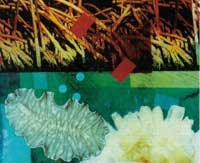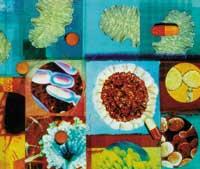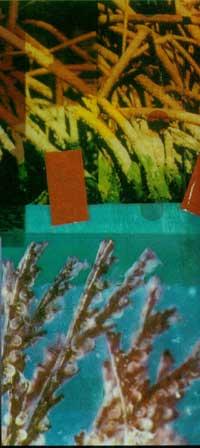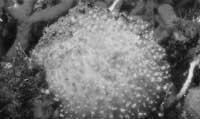Submerged
1997/10/01 Pain, Stepahie Iturria: Elhuyar aldizkaria
Brian Bingham, a young American PhD student, prepared his bags each month and traveled to the Florida Keys area. There, in the mangroves around a small island eroded by the sea, you could find some of the most beautiful ascidia colonies that a marine biologist could dream of. The colonies grew in the lentil roots of mangroves and were ideal for investigating the growth and population declines of ascidians. To find these roots on his next visit, Bingham carefully marked them with a pink fluorescent tape. And every month I took pictures of those roots, also recording the small changes that suffered many ascites.
Once, one day in the late 1980s, when he approached his boat, Bingham saw a group of divers picking up the ascites and putting them in the bags. “I thought we clearly marked the roots…”, says Bingham. “They said they didn’t know. They returned to the boat and we knew no more.”

Suddenly, drug explorers began to look for the Ecteindia turbinate, a small ascension that was not visible. This caused what explorers call “blows.” Chemists looking for potentially useful compounds can simultaneously sequester thousands of animal and plant extracts thanks to laboratory automation. And Ecteinascidia was an incredible triumph. It was found that this aqueous bag of jelly contains substances capable of killing human cancer cells.
Currently, under the direction of the Spanish company PharmaMar, one of these chemicals – 743-ekteinaszidine – is in the first phase of clinical trials in several European countries. Right now, researchers are testing this compound with terminally ill cancer patients to see how it is affecting.
It may take years to know whether or not it serves, but concerns are already spreading about the impact this research can have on diet populations. According to a sector chemist, in the Florida Keys area, about a ton of ascidia and two other tons of the Caribbean have been captured to date by divers. “At the beginning of the research we didn’t think it would become such a hot animal,” says Bingham, professor of environmental research at Western Washington University.
But the Ecteinascidia turbine is not the only target. After many years of searching for new chemicals in rainforests, drug companies are returning to the sea. In recent years, explorers have discovered three other possible stars in cancer research: a sea hare, a sponge and a zoo. In each case, the animal produces a compound that has reached clinical or pre-clinical trials of cancer. Most apparently suitable substances do not exceed the first or second session.
New technologies make scientists able to group marine beings from increasingly remote areas and increasingly more precise to study the biological effects of their chemicals, which probably increases this type of “shock.” In fact, other potential stars are already on the way (See the next big thing? (b).
This has heightened concern about overexploitation, but actions have been taken to find alternatives to the wild populations of these beings. Several researchers are designing new pathways for the cultivation of drug-friendly marine beings, opening the way for aquatic nurseries for medicines. Others aim at the artificial production of chemicals by using bacteria specifically generated by genetic engineering or cell cultures extracted from marine organisms. “These substances have begun to enter hospitals, so now we have to think about their sustainable use,” says Ami Wright, a chemist at the Harbor Branch Oceanographic Institute in Fort Pierce, Florida.
In most cases demand will exceed what the natural population can give. “The ocean is an incredible resource for new chemicals,” says Bill Fenical of the Scripps Oceanographic Institute in La Jolla, California. One reason for this is that many invertebrates live united to a rock or reef and have to defend themselves from their prey and competitors to get a stable place. In general, they use strong poisons to drive away their enemies. Many beings who can swim also seem like an easy hunt for their predators: they are inert and similar, and often express their presence with very vivid colors. They also produce toxic chemicals to prevent their capture.
But what can be avoided for predators can be very attractive to drug explorers. Most of the drugs currently used against cancer are toxic, based on the principle that rapidly growing tumor cells must die before excessive damage to healthy cells occurs. However, drug researchers are constantly looking for compounds that more directly impact cancer cells and produce fewer unpleasant costly effects. 743-ekteinaszidine is expected to be such a compound.

The problem is that most of these chemicals are only found in tiny amounts. In the case of Ecteinascidia, a ton of animals is needed to isolate 743-ekteinaszidine in one gram. Ken Rinehart, who works at Urbana-Champaigne for the University of Illinois (who isolated the compound with Tom Holt in 1980), says a person needs an average of 5 grams for clinical trials.
If 743-ekteinaszidine is finally accepted as a drug, will wild populations be able to meet demand? “So far Ecteinascidia has met sustainably,” says Rinehart. “In the Caribbean mangroves you can get three crops a year. But not everyone is so optimistic. According to Craig Young, an expert in these Harbor Branch animals, ascites will grow again and proliferate sexually if collectors abandon Raiccan stolons and attend to ascites. But if the collectors continue to cut or completely remove the mangrove roots that support the colonies, their recovery will be very difficult.
What everyone wants is a renewable source of chemicals. Aside from the ethical and ecological problems posed by ocean exploitation, it would not be wise to trust these populations that depend on nature. A growing population for a year can be devastated the following year by predators or diseases. In many cases, the cost of collecting raw material is also insurmountable, especially if the animal is deep sea. According to Wright, “people cannot pick up material by driving a diver without stopping.”
Salmon and oysters
In an ideal world, chemists would make medicine in the laboratory. However, the strange characteristics that make these chemicals so interesting make manufacturing difficult. Chemists have discovered how to synthesize the dolasatine coming out of the sea vertex, but other marine compounds have been impossible. According to Wright, “if you can’t synthesize, you should teach drug companies where to supply.”
A strategy, like salmon and oysters, is the cultivation of animals. Aquaculture has many advantages over collecting natural populations. Collecting across the sea in many species may be ineffective, as not all populations have the desired chemical. Aquaculture allows the selection of animals producing chemicals and from a productive population.
Controlled cultivation also allows handling of animals to increase production. If a sponge, for example, emits a toxic chemical to divert the algae that can suffocate it, an intense light that accelerates the growth of algae would cause a greater production of chemicals.
In practice, however, animal growth is also a challenge. Most marine beings live in very special microhabitats and are very demanding in terms of environmental conditions. According to Wright, “invertebrate aquaculture is a nightmare.” For his part, John Scarpa, his partner, tries to find out what can push ascidia to grow and reproduce in crops. Scarpa has managed to grow from larvae to adults, but has not yet been able to reproduce them. Meanwhile, try to get traps that allow animals to produce more ecteinascidins. “We’re working with annexes to see if we can change your chemistry for better performance,” he says, “if a kilo of an organism can produce a gram of medicine instead of a microgram, the cost of isolating the chemical will be much more efficient.”
One of the strategies for the future may be that chemicals are not obtained from the sciences, but from the cyhelminth they eat. Pseudoceros crozieri has ekteinaszidine in the tissues. Thus, obtaining the chemical would be easier than water ascites.
While aquaculturists still have some outstanding problems in the growth of Ecteinascidia, with two other species they have had better luck. Along the southern coast of California, Carlsbad's CalBioMarine Tecknologies company is growing a brown zoo, the Bugula neritine, which is commonly found covering the malecones. Bugula produces 1-briostatin, the complex lactone currently used in clinical trials of cancer patients in the United States.
The company CalBioMarine started the growth of the Briozoa in tanks located on land, but now they are concentrated in the sea, drastically reducing the cost of the food of these beings. The president of the company, Dominick Mendola, said that “this attitude is sensible, since in the sea nature feeds the colonies”. The first step is to sow the Bugula larvae as if they were seeds, in plastic plates with holes. When the larvae are well attached, the dishes are taken to the sea and fixed on the trays stacked from top to bottom in an underwater tower. The company received its first harvest last summer. After five months at sea, the Briozoans grew as well as the natural colonies of the region.

The second success story comes from across the Pacific. Around the coast of New Zealand, researchers from the National Institute of Hydraulic and Atmospheric Research grow another animal: The sponge that produces halicondrine B, an anticancer agent currently used in pre-clinical trials in the United States. The sponge, a newly discovered species of the genus Lissodendoryx, inhabits the South Island of New Zealand, on a small surface of a reef on the edge of Kaikoura Canyon, grows in rocky outcrops between 100 and 300 meters deep. According to Chris Battershill, group leader, “we estimate that in nature there are only about 300 tons.”
Sponges are very complicated for their growth and their conditions are very special and demanding for each species. Battershill and his team, in search of the combination to produce halicondrine obtaining the best performance, have tried to grow Lissodendoryxa in different depths and types of structures around the New Zealand coast. “If you hit, you can grow sponges in sufficient artificial conditions,” explains Battershill. Lissodendoryxa, for example, is of open sea deep waters, but now grows less than three meters deep in Wellington Harbour. According to Battershill, “we are now looking for techniques to increase halicondrine biosynthesis just before harvest.”
Ugly habits
The success of marine crops is indifferent, as animals can cause discomfort in the form of chemical factories. They don't always do what you want. They have ugly habits like getting sick or refusing to reproduce. And waste is generated in heaps. If you manage to grow only cells that do, it would be of great help.
Harbor Branchen of Florida, Shirley Pomponi, of the marine biomedical research department, studies which sponges or ascites produce chemicals of interest to their cultivation. Like animals, cells are quite strict in terms of growth conditions. And in general, the growth of invertebrate cells is more difficult than that of mammals. However, with the help of certain growth factors and chemicals, the Pomoni team has managed to divide sponges cells several times and produce the desired chemical. Mysteriously, these primitive invertebrates seem to respond to growth factors and mammalian hormones. No one knows why, but for example, sponges' cells respond to insulin in the same way as mammals, synthesizing the proteins and DNA needed for cell division.
However, it is difficult to keep the herbaceous cells fragmenting. “After some divisions they stop,” says Pomponi. “And they only produce the chemicals we want them to be active.” After overcoming this problem, Pomponi hopes to grow cells of other marine species that can produce new chemicals for science.
In some cases these animals may be complementary. Although the research is in the first steps, it is noted that some substances of interest found in marine invertebrate extracts are caused by bacteria living indoors or on animals. Marine bacteria are quite different from those of the members of the earth. Some have bromine or other halogen that are not useful for terrestrial beings. This offers possibilities for creative chemistry and explains why marine microbes of structure never seen before produce.

Gai honi buruzko eduki gehiago
Elhuyarrek garatutako teknologia





